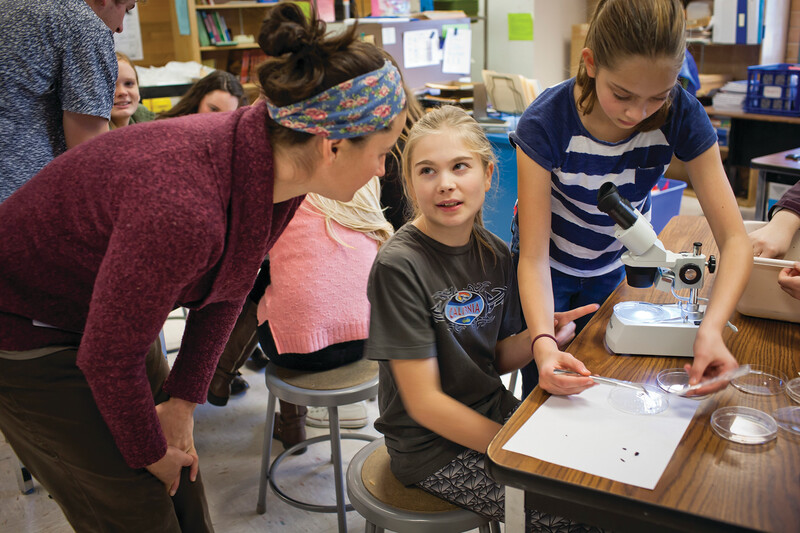Like Rome, relationships aren't built in a day. However, the beginning of the school year brings a welcome opportunity to lay the groundwork to construct those relationships—with one student at a time. Articles in this issue address connecting with specific populations of students; understanding the importance of students' culture when building relationships; developing connections between school leaders and students; and caring in a way that promotes social justice.
Engaging Boys
In "Unlocking Boys' Potential," Michael Reichert confesses that even he—a veteran researcher of boys' education—was surprised by his own research that found just how clearly boys articulated the need to connect with teachers. He writes,
In surveying what is already working in classrooms across a wide variety of schools—urban and suburban, state-funded and historically elite—thousands of teachers and adolescent males confirmed that contrary to the stereotypes of young men as diffident, disruptive, or dangerous, most boys care deeply about being successful and simply long for instructors—not to mention schools—capable of connecting personally with them.
- Do you think that some educators hold the stereotype that boys are what Reichert calls "arelational" (not interested in relationships)? If so, why do you think this is?
- Is there a gender achievement gap at your school? How does it manifest itself?
- Read Reichert's <LINK URL="http://www.ascd.org/publications/educational-leadership/sept16/vol74/num01/Unlocking-Boys'-Potential.aspx#el0916-engageboys">strategies for engaging boys</LINK> with a specific male student in mind. Write down some ways that you can connect with that student. For instance, how will you set high standards for him? How can you find and build upon a shared interest or common characteristic? In what way can you accommodate a measure of opposition?
Robert Jackson also addresses how to build healthy relationships with male students, particularly black and Latino males. He begins by presenting data, noting that black and Latino males lead in several negative statistical categories, such as incarceration, unemployment, and dropout rates. However, he highlights some positive data that show males are succeeding, such as the fact that there are more black males in honors class (14.5 percent) than special education (9.1 percent). Analyze data from your school. Where can you find evidence of success for black and Latino males? Where do you see areas of potential growth?
Special Considerations
Several articles address how to connect with specific populations of students, specifically those with early trauma histories ("The Trauma-Sensitive Teacher" by Susan E. Craig), LGBTQ students ("More Than a Safe Space" by Michael Sadowski), and those with ADHD ("Building Bridges with Students Who Have ADHD" by Lisa Medoff). In your PLC, use the jigsaw cooperative learning strategy to study this series of articles. One "expert" group (or individual) can read and study Craig's article, another can do the same for Sadowski's piece, and a third for Medoff's. Expert groups can use the questions below to begin their discussions, and then report back to the home group.
- "The Trauma-Sensitive Teacher:" What evidence does Craig offer to underscore the need for trauma-sensitive teachers in classrooms? What are some ways that you can remain objective and calm when de-escalating a child's reenactment?
- "More Than a Safe Space:" Is safety an issue for LGBTQ students at your school? Following the examples of the three schools, how might your school go about changing its climate or curriculum to be more inclusive of LGBTQ identities? What are some challenges that you might face, and how would you overcome them?
- "Building Bridges with Students Who Have ADHD:" Make a list of characteristics that Medoff describes as typical of ADHD. Drawing on your experiences, add any other characteristics that you've seen in a wide range of students with ADHD. Which of the author's strategies have you tried before? How would you amend them?
Strategies to Try
Many of the authors in the issue suggest ready-to-implement strategies to build relationships with students. Commit to trying one or more of the strategies below—or another one not listed. Report back to your PLC about what you learned.
- Try Rick Wormeli's ("What to Do in Week One?") suggestion of having students complete "the best way for me to learn" index cards. What did you learn about your students' learning preferences? How will you change your instruction to meet the needs of your students?
- Tim Westerberg ("The Principal Factor") says school leaders should have a list of non-negotiables in order to facilitate stable adult-student relationships. What are your non-negotiables, and how will you go about clarifying them for students?
- Doug Fisher and Nancy Frey ("Two Times Ten Conversations") recommend a systematic process by which an educator interacts with a student for 2 minutes a day for 10 consecutive days. Choose a student you'd like to try this with, and explain to your colleagues what you hope will come of the interactions. Afterward, debrief about whether you achieved these results.
- Christopher Emdin ("Seven Cs for Effective Teaching," online) argues for the importance of understanding the context that students come from. Ask students about places in their community that are important to them, and commit to visiting one place, perhaps a local barbershop, basketball tournament, or restaurant. How can you integrate what you learned about the students' community into your classroom?
Resources for Further Study
Use these ASCD resources to learn more about developing positive relationships with students.
How to Reach the Hard to Teach: Excellent Instruction For Those Who Need It Most (2016) by Jana Echevarria, Nancy Frey, and Douglas Fisher
Fostering Resilient Learners: Strategies for Creating a Trauma-Sensitive Classroom (2016) by Kristin Souers with Pete Hall
Engaging Students with Poverty in Mind: Practical Strategies for Raising Achievement (2013) by Eric Jensen
Beyond Discipline: From Compliance to Community, 10th Anniversary Edition (2006) by Alfie Kohn



